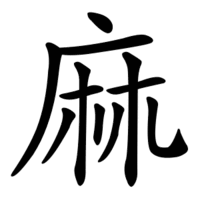Radical 200
Radical 200 or radical hemp (麻部) meaning "hemp" or "flax" is one of the 6 Kangxi radicals (214 radicals in total) composed of 11 strokes. Historically, it is the Chinese word for cannabis.
| 麻 | ||
|---|---|---|
| ||
| 麻 (U+9EBB) "hemp, flax" | ||
| Pronunciations | ||
| Pinyin: | má | |
| Bopomofo: | ㄇㄚˊ | |
| Wade–Giles: | ma2 | |
| Cantonese Yale: | ma4 | |
| Jyutping: | maa4 | |
| Japanese Kana: | マ ma / バ ba (on'yomi) あさ asa (kun'yomi) | |
| Sino-Korean: | 마 ma | |
| Hán-Việt: | ma, mà, mơ | |
| Names | ||
| Japanese name(s): | 麻/あさ asa 麻冠/あさかんむり asakanmuri | |
| Hangul: | 삼 sam | |
| Stroke order animation | ||
 | ||
In the Kangxi Dictionary, there are 34 characters (out of 49,030) to be found under this radical.
麻 is also the 193rd indexing component in the Table of Indexing Chinese Character Components predominantly adopted by Simplified Chinese dictionaries published in mainland China.
Evolution
 Bronze script character
Bronze script character Large seal script character
Large seal script character Small seal script character
Small seal script character
Variant forms
 Radical 200 in the Kangxi Dictionary
Radical 200 in the Kangxi Dictionary.svg.png.webp) A variant form
A variant form.svg.png.webp) Standard form in Traditional Chinese
Standard form in Traditional Chinese.svg.png.webp) Standard form in Japanese
Standard form in Japanese.svg.png.webp) Standard form in Simplified Chinese
Standard form in Simplified Chinese
Simogram
As an independent sinogram 麻 is a Jōyō kanji, or a Kanji used in writing the Japanese language. It is a secondary school kanji.[1] It means cannabis and is part of Onusa
See Also
References
- "KANJI-Link". www.kanji-link.com. Retrieved 2023-06-02.
Literature
- Fazzioli, Edoardo (1987). Chinese calligraphy : from pictograph to ideogram : the history of 214 essential Chinese/Japanese characters. calligraphy by Rebecca Hon Ko. New York: Abbeville Press. ISBN 0-89659-774-1.
- Lunde, Ken (Jan 5, 2009). "Appendix J: Japanese Character Sets" (PDF). CJKV Information Processing: Chinese, Japanese, Korean & Vietnamese Computing (Second ed.). Sebastopol, Calif.: O'Reilly Media. ISBN 978-0-596-51447-1.
This article is issued from Wikipedia. The text is licensed under Creative Commons - Attribution - Sharealike. Additional terms may apply for the media files.